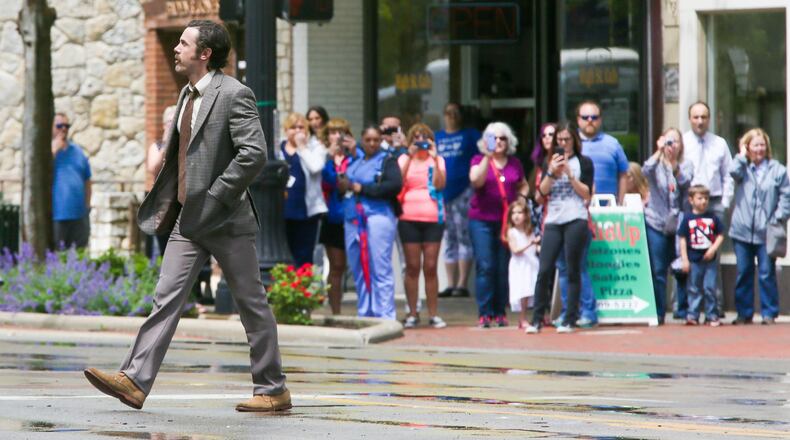RELATED: Lawmakers increase film tax credits (May 2016)
Since the tax credits took effect in 2009, the city of Hamilton has seen 11 films use Butler County communities as a backdrop. That includes Robert Redford/Casey Affleck movie "Old Man and the Gun," the John Travolta movie "Gotti" and the Zac Efron movie "Extremely Wicked, Shockingly Evil and Vile" in which he plays serial killer Ted Bundy.
“It’s all about the tax credits,” said Steve Colwell of Film Hamilton. “If we don’t have the tax credits, we won’t have the films here.”
A 2016 study by the University of Cincinnati Economics Center estimated the film industry created a $54 million economic impact in greater Cincinnati in 2014 and 2015 and since 2014 has created 8,800 part- and full-time jobs with $11.8 million in taxpayer support.
RELATED: Downtown Hamilton transforms for Robert Redford, Casey Affleck movie
Since the tax credit program took effect in 2009, there has been a $572 million economic impact to the state, according to House Government Accountability and Oversight Committee testimony by Ivan Schwarz, president of the Greater Cleveland Film Commission.
Ohio is one of 34 states to offer some type of incentive — either in the form of a tax credit, rebate or grant — for movie makers and TV productions to film in the state.
Colwell said if Ohio wants to stay competitive with other states, including neighboring Kentucky, West Virginia and Pennsylvania that have similar incentives to Ohio, then lawmakers need to increase the tax credits. Kentucky and Georgia have the best incentives for movie makers and TV productions, according to the Film Production Capital, a tax credit brokerage company based in Louisiana.
“If we want to keep films coming, we have to have the incentives,” Colwell said. While there have been 11 films that shot most or some of their scenes in Butler County, “we’ve lost that many because filmmakers didn’t get the tax credit. It simply comes down to the money.”
Schwarz said the state has collectively lost more than $1 billion in production that would have filmed here if the incentives were higher and if the state had the infrastructure, such as movie studios.
“A strong film industry is good for Ohio,” he said. “A strong film industry can help retain Ohio’s young talent in large numbers and create jobs for them right here at home.”
Not all support increasing the tax incentive. Wendy Patton with Policy Matters Ohio said increasing the tax credit would cost the state’s general fund en estimated $58 million and local governments and public libraries around $2 million.
“Tax credits are often premised on the claim that the economic activity they generate will more than replace taxpayer dollars given in the subsidy,” according to her testimony to the House Government Accountability and Oversight Committee.
Citing a 2015 Cleveland State University Study, she said Ohio spent $32 million between 2011 and 2015 on tax credits but total taxes generated as a result was around $22 million.
However, more recent studies, such as that produced by the University of Cincinnati Economics Center, cited higher returns on investment, including Ohio earning $1.50 for every $1 spent on the tax credit. The Greater Cleveland Film Commission says that’s even higher, with $2 being returned to the state’s economy for every $1 spent on the tax credit.
Filmmakers chase tax credits, the Journal-News reported last year. And not only do producers chase incentives but their productions lure out-of-state financing for projects that will often have locations in multiple cities, like the Robert Redford/Casey Affleck movie “Old man and the Gun.” That production spent three days in downtown Hamilton, but it also filmed in Cincinnati, Dayton and other Southwest Ohio communities.
“Old Man and the Gun” received roughly $3.4 million in tax credits and employed hundreds of people, including movie extras and production crew.
Kristen Schlotman, executive director with Film Cincinnati, said the increase of tax credits would be “critical to Ohio’s ability to compete” with neighboring states. Cincinnati alone saw around $38 million in impact due to the film industry, she said.
“The film industry is increasingly competitive both domestically and internationally,” she said in testimony to the House Government Accountability and Oversight Committee, which has had four hearings on the legislation. “The availability of tax credits has become an extremely important factor in producers’ decision-making process of where to shoot in the U.S.”
Schwarz said taking the film credit program “to the next level” will establish a year-round industry, thus helping the state create more permanent jobs.
“This bill will encourage Ohio businesses to grow and attract new businesses to Ohio,” he said. “It will keep young people from leaving the state seeking employment elsewhere and attract new people to move here to work in this new industry.”
Cleveland, and other northern Ohio areas, have seen most of the tax credits issued, and that area of the state has capitalized on that, including seeing a new stand-alone film school at Cleveland State University that opens this August.
Expanding tax credits will also give communities like Hamilton — which has an estimated population of nearly 62,200 — an opportunity to develop their own niche in the industry.
“Hamilton is Hamilton. We’re not going to compete with Cleveland, Columbus and Cincinnati, but we do offer something unique that no others can,” Colwell said. “We’re easy to work with, we have a unique location and we’re big enough but with a small downtown.”
About the Author

